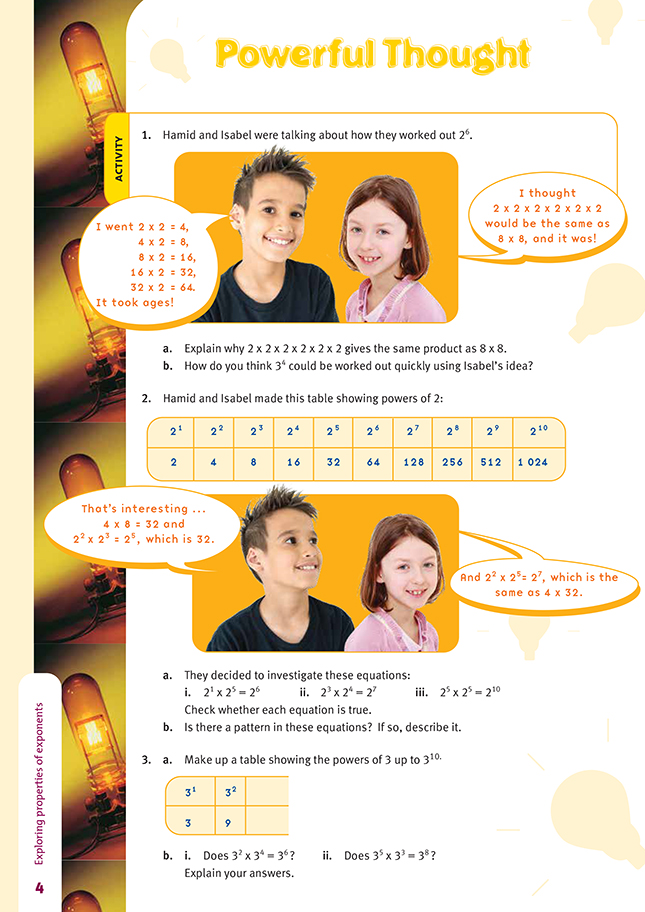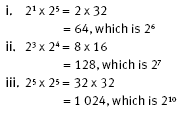This is a level 5 number activity from the Figure It Out series. It relates to Stage 8 of the Number Framework.
A PDF of the student activity is included.
Click on the image to enlarge it. Click again to close. Download PDF (216 KB)
investigate properties of exponents
FIO, Level 4+, Number, Book Six, Powerful Thought, page 4
Some students may need to revise their knowledge of exponents. You could help them by asking whether they know of a short way to represent, say, the volume of a cube that measures 4 centimetres by 4 centimetres by 4 centimetres, that is, 4 x 4 x 4 (having one on hand with the squares drawn on the outside faces would be very useful). Some may want to say that this is three 4s instead of 43, in which case you may need to go back to using squares. With a 4 by 4 square ruled on card, the students will be able to see that 4 by 4 is not the same as two 4s because two 4s is 8, not 16. You may need to show them the conventional way of writing the squared figure of 2 (that is, 42. Then they could learn that there are two ways of saying this,
namely 4 squared (after all, it is a square) or 4 to the power of 2. This may give them a better basis to deal with the 4 by 4 by 4 cube and to learn that the numeral 43 can be called 4 cubed (it is a cube, so this should make sense) or 4 to the power of 3. “To the power of” thus means the number of times that a number is multiplied by itself. It is worth commenting to the students that with powers higher than 3, the only way to express the power is “to the power of …”, for example, to the power of 7.
In activity 1a, the product of 8 x 8 stems from the use of the associative or grouping principle, which works for both multiplication and addition. In this case, 2 x 2 x 2 x 2 x 2 x 2 has actually been grouped as (2 x 2 x 2) x (2 x 2 x 2). If necessary, help the students to recognise that this is the associative principle in action and that it can provide a powerful means of mental calculation. It can also be used in other multiplication settings, such as 15 x 7 x 2 x 10. Combining the commutative and associative principles allows this to be done mentally, that is: (2 x 15) x 7 x 10.
Question 2 provides an opportunity for the students to identify (if they have not already done so) the pattern in which exponents are added to find the product of two equal numbers. For example, by working out that 22 x 24 is 64 or the same as 26, they may begin to see that adding the exponents, in this case 2 + 4 gives the
exponent of the product.
With question 3, suggest to the students that they can generate the powers of 3 (or any other number) on the calculator by using the constant function. By keying in 3 x = = = or, on some calculators, 3 x x = = = , they will get the next power of 3 each time that they press the = button. To ensure that the students understand what is happening here, you may need to ask, “How many times have you multiplied
3 by itself now?” If the students have scientific calculators, you could show them how to use the xy button, where x is the base number and y is the exponent. For example, for 34, they would key in 3 xy 4 = .
Answers to Activity
1. a. 26 can be regrouped as
(2 x 2 x 2) x (2 x 2 x 2) = 8 x 8
= 64
b. 34 = (3 x 3) x (3 x 3)
= 9 x 9
= 81
2 . a. Yes, all the equations are true.
b. Adding exponents gives the exponent of the product:
2a x 2b = 2a + b
For example: 22 x 23 = 2(2+3)
= 25
3. a.
b. i. Yes. 32 x 34 = 9 x 81
= 729, which is 36
ii. Yes. 35 x 33 = 243 x 27
= 6 561, which is 38
In both cases, the exponents of the factors add up to the exponent in the product.
Working out the equation shows this to be true.


